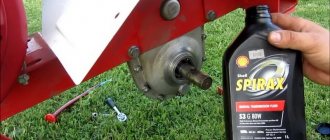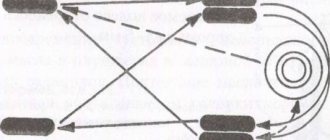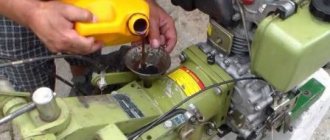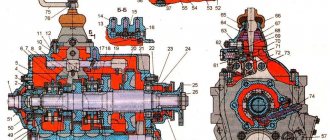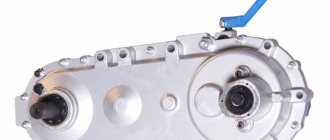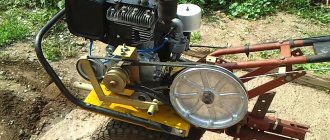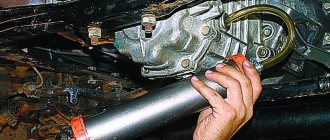When purchasing a walk-behind tractor, you have high hopes for it. First of all, I want this equipment to perform its functions efficiently and serve faithfully for many years. The key to this is not only the high-quality production of the equipment itself, but also the correctness of its operation. First of all, you need to carry out timely oil changes. Many people make mistakes when carrying out this procedure. Now we will tell you how to properly change the oil for a walk-behind tractor and whether it needs to be added to gasoline.
Features and types of oils
To find out in what proportions to dilute gasoline with oil for a walk-behind tractor, it is again better to refer to the instructions.
But often they use a ratio of 1 to 4 (one part oil to four parts gasoline). At the same time, there are engines that are equipped with an additional gearbox. From time to time it is also necessary to change the oil there. Pure gasoline or oil is poured into the walk-behind tractor - we’ve already figured it out. But what oil to use for this remains a mystery. Oil is one of the main factors ensuring the functioning of the engine. The best advice would be to follow the recommendations provided by the walk-behind tractor manufacturer itself. When choosing, it is worth considering such parameters as the degree of viscosity and category of application.
- Summer. They do not have a letter designation. They have high astringent qualities and are used during the hot season. These are SAE 20, 30, 40, 50, 60.
- Winter. Indicated by the symbol W or Winter. Such oils have low viscosity and are used in the coldest seasons. These include - SAE 0W, 5W, 10W, 15W, 20W, 25W.
- All-season. These are universal oils that are the most popular among people. They can be used regardless of the ambient temperature. But there are differences between the winter and summer series - 5W-30, 10W-40. The lower the temperature, the lower the viscosity must be selected.
But the use of oil with several viscosity indicators is characterized by stability in all respects under conditions of temperature changes.
Now you know whether it is necessary to add oil to gasoline for a walk-behind tractor and in what proportions to dilute gasoline with oil for a walk-behind tractor. The main thing is to always monitor the condition of the unit and carry out timely maintenance and repair work so that it serves you for as long as possible and with the highest productivity.
Common problems
The main reason why car oil comes into contact with fuel is severe wear of the compression/oil rings. Gasoline flows into the crankcase, oil enters the combustion chamber. All this indicates that the power unit needs to be overhauled, since it has accumulated many serious faults.
The engine becomes much weaker if the compression of at least one cylinder decreases. Excess fuel in the combustion chamber also does not lead to anything good. Carbon deposits will increase and the engine will constantly overheat. Consequently, the viscosity of the automotive lubricant will change. In other words, the oil will begin to thin out. This is unsafe for an engine operating at high speeds under harsh operating conditions.
The consequences of any malfunction can be minimized if the problem is detected in time. You need to pay attention to the above signs of a leak. Then you won’t have to go to a car service center to have your car’s engine completely repaired. This service is quite expensive, so it is better to know what the main signs of fuel getting into the oil liquid are. This will make it possible to avoid many significant financial expenses.
First launch of the cultivator
The first serious problem faced by users. It's like starting a machine. First you need to check the fuel level and oil. Motor cultivators are supplied with an empty tank and crankcase, so they must be refilled first. However, you should get into the habit of checking the oil level before each start. To start the unit, turn the ignition to the on position. Open the fuel valve and close the choke valve. Next, you need to pump fuel into the carburetor, grab the starter handle and gently pull it several times until you feel resistance, then make a sharp jerk. After the engine has started, open the choke. Be sure to warm up the engine and let it idle for at least a minute. This rule must be observed before each start. This way you will extend the life of the unit.
Do not throw the starter suddenly, be sure to smoothly bring it to the end. Otherwise, it may wrap around the flywheel, causing damage.
Method 1: grind the cylinder head
The cylinder head (cylinder head hereinafter) is the most important part in the design of any gasoline engine, controlling the process of fuel combustion and gas exhaust. It is located on top of the cylinders themselves. The purpose of its milling is to reduce the size of the combustion chamber, which in turn will increase the compression and compression necessary for working on high-octane gasoline. The acceptable degree of milling is considered to be 3.5 mm. This means that if the cylinder head on the walk-behind tractor was 95 mm, after milling there should be 91.5 mm left.
Progress:
- remove the cylinder head after sequentially disconnecting the bolts and nuts;
- remove oil seal caps;
- remove possible carbon deposits, traces of oil and dirt with a solvent - ordinary acetone or diesel fuel will do;
- Having a clean head, start milling. To do this, you don’t have to look for a specialist milling machine. Having an emery wheel at home, you can do this yourself. Considering that the cylinder head of most walk-behind tractors is made of aluminum, and not their cast iron, to create a perfectly smooth surface of the established thickness, it will have to be additionally sanded with emery cloth attached to a flat block of wood or glass;
- Once the visible grooves have disappeared, you can begin polishing the working area of the valves.
Having cleared the coolant hoses of metal dust, you can install a cylinder head adjusted to the required dimensions.
In addition, to ensure greater reliability of the conversion:
- install new caps and valves themselves;
- change the used cylinder head gasket;
- take reliable bolt ties (for example, with a diameter of 1.1 cm), which are tightened with a torque wrench so that the load on the connection is 7.5 kg/s. For larger diameter studs, this figure increases to 9.5 kg/s;
- While tightening, make sure that the correct gaps are maintained between the outer valves - 0.3-0.35 mm. For all others - up to 0.4 mm is permissible;
- Considering that the cylinder head has shrunk in size, the original cultivator push rods will no longer fit. Instead, you need to put shorter ones.
After all the nuances are met, the motor part is assembled. Before starting the walk-behind tractor on 92nd fuel, check and, if necessary, clean the carburetor.
3rd method: by installing additional gaskets (changing the gasket)
If the previous methods of converting a walk-behind tractor to 92 gasoline seem too labor-intensive, you can limit yourself to simpler ones. The first of them is based on the fact that the cylinder head is reinforced with 3 additional gaskets at once. The middle one will remove excess heat. It is ideal if you have silumin or another made of light alloy material on hand.
All of them must be commensurate with each other. It is important to calculate the thickness of the middle gasket.
To do this, use the formula (all in mm):
Vsr = 4 mm - (Vv + Vn) + 0.7 mm (shrinkage coefficient), where:
Вв – height of the upper gasket;
Vn – bottom.
The valve pushers that were on the old MTZ-05 or MTZ-12 walk-behind tractor may remain old. Only their rods need to be replaced (they are needed shorter than in the design for 80-octane gasoline).
The second is the usual replacement of the gasket between the cylinder and the cylinder head. The standard ones are replaced with more durable ones, for example, made from paranite.
As you can see, after minor modifications, the walk-behind tractor can operate stably on high-octane gasoline.
Is it possible to pour 92 gasoline instead of 80 into a walk-behind tractor?
AI-92 gasoline is an order of magnitude higher than 80. But you shouldn’t experiment and refuel garden equipment with better fuel if the engine is not designed for it.
If you suddenly change the fuel, then simple models of walk-behind tractors simply will not start. Even if the equipment starts, using fuel with a higher octane number will cause breakdowns:
- the main elements will quickly fail;
- the gearbox will stop working;
- if the walk-behind tractor starts, you will need to change the oil seals and filters much more often;
- fuel demand increases.
Before you start using AI-92 gasoline instead of AI-80, you should prepare the equipment. There are two ways to solve the problem:
- increasing the engine compression ratio;
- adjusting the advance angle of the ignition system.
If you do not have the knowledge and skills to repair such equipment, then it is better to turn to professionals. They will solve problems accurately and accurately.
How much gasoline does a chainsaw consume?
The fuel tanks of most gasoline saws have a volume of 0.3 to 1.0 liters. How often you need to pour the fuel mixture into the chainsaw depends on the chosen brand, engine power and intensity of work. In logging and wood construction, professional chainsaws are used, characterized by high power and a long period of continuous operation. For housekeeping in a village house, in a country house, or for the occasional production of wood products, less productive, but lightweight and convenient household models are used. For a professional tool with a power of 5-6 kW, fuel consumption when sawing logs can reach 3.0 l/hour. For less powerful models with a 1.5-2.0 kW engine, it fluctuates at 0.6-0.8 l/hour.
How does fuel penetrate into the crankcase with lubricant?
Gasoline enters the crankcase in the following ways:
- Via the main oil pump. The lower area of the pump diaphragm protects the upper area from harmful gas vapors from the crankcase. It is worth checking the condition of the diaphragms sometimes.
- Through a carburetor. This happens if the needle valve is defective. The car is overloaded, which leads to high fuel costs.
To prevent drained fuel from accumulating under the carburetor, it is necessary to remove it through a special drainage tube built into the manifold. If the tube becomes clogged, excess fuel will end up on the engine cylinders. If the temperature is high, they will evaporate almost immediately. When starting the engine coldly in winter, especially in severe frost, fuel will flow along the walls into the crankcase. This will result in the formation of a mixture of gasoline and oil.
It often happens that the driver is unaware of the penetration of fuel into the lubricant until the indicator of high pressure in the oil complex lights up on the instrument panel.
Is it necessary to fill the gearbox of a motor cultivator with oil?
The gearbox is responsible for transmitting torque in the walk-behind tractor from the motor to the wheels. Components are very susceptible to wear, so they need constant high-quality lubrication. Not every oil can be used for such purposes.
The ideal option for lubricating the gearbox is gear oil. It perfectly lubricates moving parts.
In order not to harm the device, you will need to clearly determine how much oil needs to be poured into the gearbox. Check the need to replenish the substance in the reducer using a long wire. The wire is inserted into the filler hole until it stops. Then they pull it out and see which part of it is wet:
- if the wet area is 30 cm, then there is no need to add lubricant;
- if the rod is soaked less than 30 cm, then the substance is added to the 30 cm mark.
On a note!
The oil in the gearbox is changed approximately once every 100 hours of operation of the walk-behind tractor. The frequency of changing the lubricant also depends on the manufacturer’s recommendations. Also, the frequency of oil changes depends on the frequency of work. If the motor cultivator operates more than 4 hours a day, then replacement is carried out every 50 hours of operation.
What are the dangers of mixing fuel with lubricant?
When gasoline gets into the engine oil, it triggers complex reactions that ultimately lead to various breakdowns. It should be added that everything depends on the volume of fuel that is in the engine oil. If it is small, the motor will work normally for a little longer. However, serious problems will still appear. If there is a large amount of gasoline in the crankcase, this quickly leads to car breakdowns.
Consequences of gasoline penetration into oil:
- violation of the fuel correction coefficient. The power unit sometimes cannot be started;
- decreased driving speed, the car has difficulty reaching maximum speed;
- piston failures occur;
- engine failure. This happens when the carburetor or injectors are damaged.
How can you tell if your car has a problem? You need to pay attention to certain signs:
- increased fuel costs. Gasoline is consumed quickly due to the fact that some of it flows into the engine for lubrication;
- strong knocking, noise in the piston system. This is evidence that fuel processing is disrupted;
- engine power decreases, making it more difficult for the car to drive up hills;
- the color of the oil changes;
- The coolant level drops.
What to do if you notice one of the above signs? Go to a car service immediately.
Is car oil suitable for a walk-behind tractor?
Many farmers mistakenly believe that automobile motor oil can be used for walk-behind tractors, since there are no differences between them. And this is a big mistake. Since the product for cars does not have the characteristics necessary for a motor cultivator.
The result of using oil for a car will be:
- acceleration of the wear process of the piston group and cylinders;
- complex breakdown;
- replacing the entire engine.
To refuel walk-behind tractors, special motor oil is used. It comes in two- and four-stroke versions. The type of oil is selected depending on the engine used in the walk-behind tractor.
For normal operation of the walk-behind tractor, you need to monitor not only the condition of the engine and gearbox. Each component part requires attention and care. All moving parts should be disassembled and lubricated periodically, and garden equipment should be kept in good condition.
Signs of a Leak
Is it possible to understand that there is a leak? You can find out about this by noticing a dark puddle under the car. It happens that lubricant leaks from under the valve cover lining, oil seals or crankcase gasket. Motor oil can only be mixed with fuel in the engine. It is possible to determine that gasoline has entered the oil liquid by the following signs:
- the viscosity of the oil changed, it became thinner;
- the car oil on the dipstick lights up if you bring the flame close to it;
- A drop of oil on a piece of paper leaves a greasy, growing stain.
Troubleshooting
When you smell gasoline in the oil, it is usually recommended to go to a car service center. If things have gone too far, there is no other way out.
However, at the beginning, when there are no significant car malfunctions, the driver has the opportunity to fix the problems on his own. To do this, you need to quickly drive the car for a couple of kilometers, then drain the lubricant and check whether there is gasoline in the oil. If it is not there, then you have managed to get rid of the smell of gasoline.
Foreign manufacturers recommend diagnosing a car this way. Take the highway frequently to dump excess fuel. Thanks to this, you will be able to get rid of the problem at its very beginning and prevent significant breakdowns. You won't have to spend money on expensive repairs.

